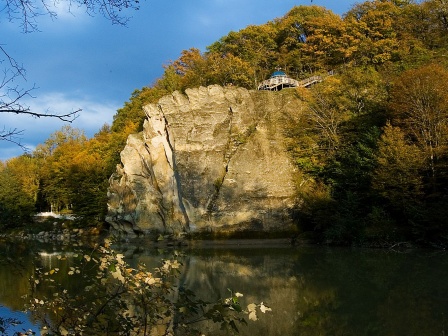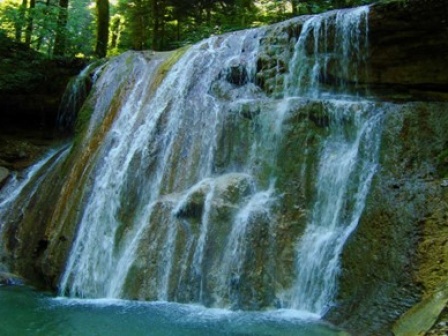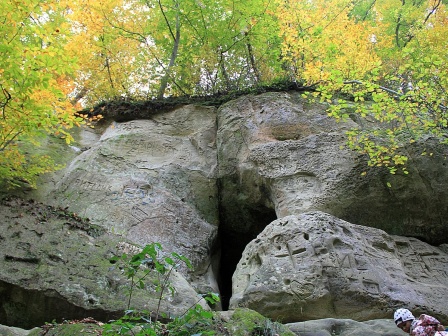Resource base
Climate
- The average annual precipitation is 858–1,096 mm.
- The prevailing winds throughout the year are southwest winds.
- From May to September, the weather is considered comfortable.
- The climate is suitable for tourist and recreational activities and agriculture.
Mineral
resources
Fresh water
reserves
- Extraction of fresh groundwater for household and technological water supply from category B reserves amounts to 9377.00 thousand cubic meters per day
Fertile
lands
- The fertile soils of Goryachiy Klyuch cover 21,058 hectares, primarily consisting of exhausted gray forest and forest-steppe soils.
Recreational resources
- The recreational resources in Goryachiy Klyuch hold significant aesthetic, cognitive, and health benefits. These resources can be utilized in different forms of tourism such as ecological, ethnic, weekend getaways, educational, sports, including trekking (hiking in the mountains towards the Black Sea), horseback riding, as well as mountaineering and rock climbing.
- Possible fishing spots include the village of Martanskaya with 2 reservoirs, as well as the rivers Psekups, Kavyarze, and Marta.
- The city beach is situated in the central area of the city within the Park of Culture and Recreation, named after the 30th anniversary of Victory. The Psekups mineral springs can be found on the right bank of the Psekups river, at the base of Abadzekhskaya (Kluchevaya) mountain, on the southwestern edge of the city.
- In the sanitary resort area, there are two types of mineral water: hydrogen sulfide water and sulfide and alkaline water of low concentration. The public hunting ground spans an area of 24,555 hectares.
- Natural landmarks: Podnavisla tract, Ayuk waterfall, Bogatyr caves, Mirror Rock, Large Fanagori cave, Kaverzinsk waterfalls, Devil's Mouth waterfall (Psechiako), Kotkh Ridge, Maltsev brook.
Mirror Rock
The Mirror Rock in Goryachiy Klyuch is a sleek rock that stands 32 meters tall, situated only 4 kilometers from the city center.
The rock is named for its sparkling appearance during the day when sunlight hits it, making the sand grains within it glisten like a mirror.

Rock of Salvation (Cockerel)
One of the most well-known natural landmarks in the Caucasus is the rock situated at the north-western tip of the Kotkh ridge. Standing at 27 meters tall, it offers a stunning view from its upper ledge, showcasing the serene waters of the Psekups and the Pshaf ridge. The peak of the rock is characterized by six peaks resembling a rooster's comb, earning it the nickname “Cockerel”. Additionally, the rock features two small caves named Zvonkaya and Salvation, with a steep staircase known as the “Stairway of Life” between them.

Kaverzinsk waterfalls
On the right tributary of the Kaverze River, there is a stream called Tambovskaya Slit. It runs close to the village of Khrebtovoye, with the Don highway located just five and a half kilometers away. Along the Tambovskaya Slit stream, you can find the Kaverzinsk waterfalls, with the main one standing at a height of 10 meters.
In total, there are over a dozen waterfalls, but the most popular among tourists is the Big Kaverzinsk waterfall. At this waterfall, a strong stream of dark blue water cascades from a twelve-meter height, filling a large basin. To ensure all visitors can enjoy the water's beauty, a viewing platform has been built near the main cascade, reachable via a staircase carved into the rock. This location is often used for leisure breaks.
Dante's Gorge
An unusual natural monument lies at the foot of Abadzekhskaya mountain, shaped by both nature and human hands. Nature carved out a narrow rocky crevice on the mountain slopes, reaching depths of up to 15 meters, while people constructed a stone staircase at the base and enhanced the surrounding glade.
According to one version, Dante's Gorge is named in honor of the Italian poet, thinker, and scientist of the Renaissance, Dante Alighieri (1265–1321). His poem “The Comedy”, later known as “Divine”, portrays the poet's journey through the afterlife. The gorge mirrors the dark, damp, and chilly ambiance of his literary masterpiece.

Bogatyr caves
The most popular tourist destination. The origin of these caves remains largely unknown. The rock base, made of compacted sandstones, was created in the final period of the Cretaceous era, approximately 5–8 million years ago, through the layering of sedimentary rocks. The caves, small indentations in the central area of the rock, formed at a later stage.


